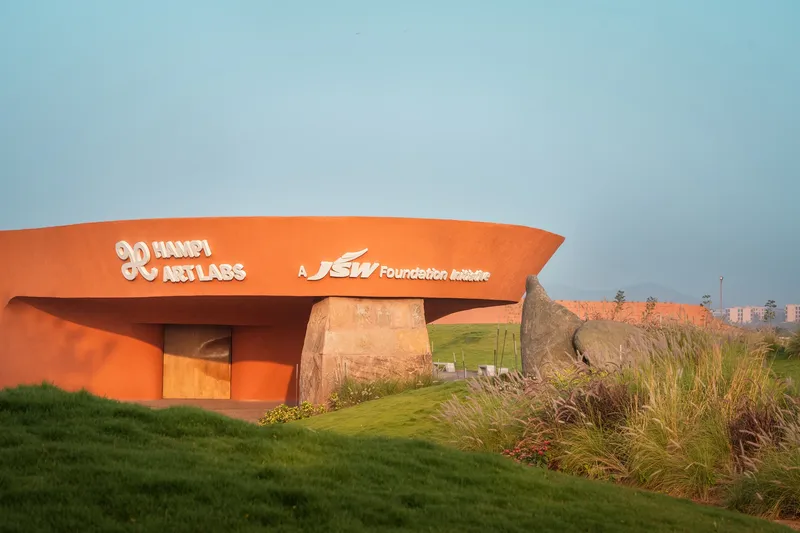The rise of multi-art centres in India and its significance
New-age art centres celebrate the organic connections between community and crafts. These spaces are less intimidating and formal, allowing a free movement of thoughts and dialogues among practitioners and enthusiasts.
Art spaces allow us to reimagine the world. They make us feel human. Today, the number of these spaces are on an upswing in India. They are less limiting and highbrow, more accessible, and more experiential in character.
Art and its spectrum of interactions with people lead to cultural enrichment, helping us fix things that are broken in this world. The idea of cultivating knowledge to set in motion social change is also intimately connected to the transformative potential of arts–because art and its diverse unconventional expressions can lead to new ways of learning, challenge the status quo, and take humanity into new directions.
Art has always existed at the core of Indian society. However, traditional spaces allotted to the arts and cultural practices have, over the years, been mired in bureaucratic tangles, resulting in their transformation into elite institutions with a formal and rigid spirit. But now they have ceded space to a new, burgeoning crop of art centres that celebrate the organic connections between the community and crafts.
These spaces are less intimidating and formal, allowing a free movement of thoughts and dialogues among practitioners and enthusiasts.
One of the earlier movements championing a more flexible artistic debate and practice include SPIC MACAY (Society for the Promotion of Indian Classical Music And Culture Amongst Youth), started in 1977 by Dr Kiran Seth. Since its inception, it has gone against the tide to bring together two contrasting threads of the Indian musical and cultural heritage.
While the society has successfully organised national and international conventions, spotlighting the unimaginable musical talents of this country, it has also been a harbinger of change. It has had the courage to hope that young people will carry forward, revitalise and energise the Indian music space. The musical programmes conducted through a worldwide network of schools, colleges and educational institutions are the building blocks of a future society transformed through the meditative and reflective experiences of artistic practices. It has birthed the notion of the arts being both multi-disciplinary and immersive.
In recent years, several organisations are either following in the footsteps of SPIC MACAY in the immersive and innovative arts space or becoming pioneers in their own right.
For instance, the Nita Mukesh Ambani Cultural Centre (NMACC) in Mumbai is striving to loosen the contours of artistic explorations. It has staged the debuts of Broadway and West End in India and has also anchored its thoughts on the spectrum of Indian classical and folk arts.

The Hampi Art Labs spreads across nine acres of barren land
Others are breaking the mould too, freeing art practices from straitjacketed confines and making them appealing to a new demographic profile. The Hampi Art Labs in Karnataka offers new possibilities in the realm of art, drawing into its fold residency programmes encouraging art practitioners to play around with unorthodox materials and techniques, while allowing interactions with the local community to shape and mould their outputs.
The shooting graph of multi-disciplinary, immersive art centres is indeed the need of the hour. An umbrella of reasons has recently nudged the rise of immersive art spaces. A new wave of Indian audience, exposed to best global creative expressions, is waking up to tune into non-traditional, experiential and participatory art forms.
Owing to the democratisation of technology in the current day and age, a whole new world created by maverick art practitioners as well as expressions by historically underrepresented groups are being accessed by Indians.
Technology is boosting the shape and quality of the new age artist’s oeuvre too. It is helping artists address the need for more immersive art experiences, including video, multimedia and animatronic, while lending a hand in creating more accessible and inclusive art spaces.
Immersive art centres serve other functions too. Cultural and idea exchanges through meaningful debates, dialogues, collaborations and networking contribute towards expanding the horizon of audiences and inform the practice of artists simultaneously. In the process, these immersive art centres are also tapping into the cultural conversation of our times, connecting the next generation of artists with a new and vibrant audience base.
One should also acknowledge that multidisciplinary art centres have deep connections with a hopeful economy. India’s current ranking as the fifth largest economy has strengthened the relationship between market realities and the art scene. An ambitious economy is fuelling the growth in the art space, while the art output is creating value as an asset category in a thriving marketplace.
Of course, art’s real value lies in its profound impact on its viewer. It is regarded as a promise because it allows people to experience the possibility of crafting an alternative world. They can visualise a space that coaxes its inhabitants to reflect, arouse the senses, stimulate the mind, and forge human connections. Art centres are aimed at healing, transforming ourselves and finding new trajectories in life.
The author is the Founder of Arthshila, an immersive platform for the arts.
Edited by Swetha Kannan







